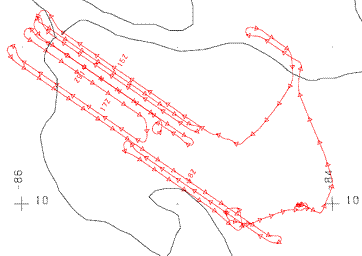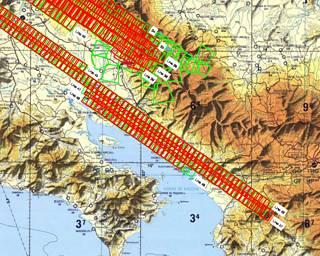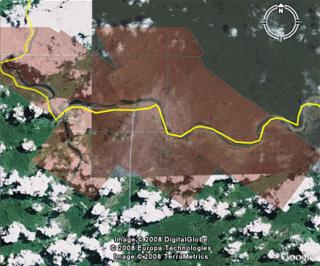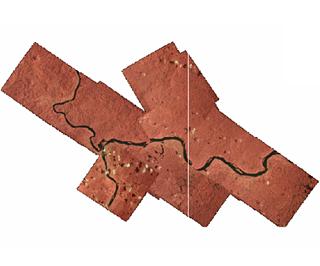Costa Rica 2050: Web-Enabled Access to Integrated Large Size Airborne Imagery of Costa Rica
The project of visualization and analysis of the aerial land images of Costa Rica, obtained from the CARTA 2003 and CARTA 2005 missions is part of a broader initiative called the Advanced Research and Technology Collaboratory for the Americas (ARTCA). Activities of researchers from the Instituto Tecnologico de Costa Rica (ITCR), Centro Nacional de Alta Tecnología (CeNAT), National Center for Supercomputing Applications (NCSA) and universities are coordinated by CeNAT in Costa Rica.
Project Overview: (a) Pre-process and integrate large size airborne imagery from three sources for two distinct years 2003 and 2005. (b) Manage the data and enable easy web access for browsing. (c) Prepare a methodology, data workflows and optimal parameters for next CARTA mission.
Motivation: It is a significant investment of the order of several million dollars per CARTA survey for people of Costa Rica to acquire airborne imagery. The access to integrated imagery would have a significant positive impact on the economy of Costa Rica. The main objectives are:
- Urban and regional planning (Revenues from tourism vs sustainability of the environment, deforestation and water quality).
- Update national cartographic database.
- Assist in developing land use policy and a land use database, real estate and insurance business.
- Support academic research (Tropical forest ecosystems and agricultural research, plant science - coffee and banana plantations, bio-diversity monitoring, bio-mass monitoring, etc.).
- Study volcanic activity and hazards (impact of volcanic gases on agriculture), emergency management for other natural disasters (establishing landslide zones).


The area of Costa Rica has been scanned with various sensors (high resolution visible camera, infra-red camera, MASTER - thermal emission and reflection radiometer etc.) in order to acquire airborne multispectral digital imagery and photographic data for the ecosystem and agricultural research, for urban and land use planning, for studying volcanic activity and hazards and for cartographic purposes.


Typical flight of the CARTA 2005 mission. Flight path and the area scanned are shown. Red and green boxes correspond to the acquisition from the RC-30 camera system in visible spectrum and Digital Camera System (DCS) in false color infrared imagery respectively. Data from the NASA Flight Summary Report.
Sensors used in multispectral digital photographic imagery: (Main source: NASA Flight Summary Report)
- Leica RC-30 metric camera is used for natural color imagery with wavelength range 420-700nm mainly for surface mapping and monitoring. Precision photogrammetry and films may be used to generate digital elevation models.
- Cirrus Digital Camera System (DCS) is used for acquiring flase color infrared imagery with 510-990nm spectral range. Primary use is in habitat mapping and ecosystem monitoring.
- MODIS/ASTER (MASTER) is the airborne simulator of the NASA satellite instrument, orbiting on NASA's Terra satellite (ASTER - Advanced Spaceborne Thermal Emission and Reflection Radiometer and MODIS - geographic reprojection tool). It is intended primarily to study geological and other Earth surface properties. Fifty spectral bands cover 435nm - 13,110nm (13.11µm).
- HyMap Hyperspectral Scanner provides 126 bands across the reflective solar wavelength region of 0.45 - 2.5nm with contiguous spectral coverage (except in the atmospheric water vapor bands) and bandwidths between 15 - 20nm. High spatial and spectral resolution is used for example to differentiate a wide range of minerals at the ground surface through their characteristic absorption spectra.

An example of Hyperspectral imagery. ASTER/MODIS Airborne Simulator from CARTA-2 2005, flight #05-003-31, Track #8. Images were taken at wavelength (from left) of 0.66µm, 1.50µm, 3.74µm, 11.31µm and RGB.
Prototype of the large size imagery: 22 Tiles ~ 1.6GB of the near-IR imagery of the Rio San Juan region.
Location: Confluence of the San Juan and San Carlos rivers.


Left: Surface image with the near-IR map overlayed. Right: The prototype for serving and browsing the near IR airborne imagery (22 tiles).
Future Steps:
- Visualisation through Geospatial browsers: Google Maps, OpenLayers, MapBuilder etc.,
- Linking the project to other efforts in Costa Rica and in the US,
- Identifying customers to build a sustainable business model to avoid a one-time effort (customers, users, stakeholders),
- Pricing as a function of spatial resolution and time,
- Tradeoffs between survey requirements and associated costs,
- Securing financial commitments from stakeholders,
- Sharing human resources,
- Sharing computational resources,
- Providing a product for new analytical opportunities, for instance, year-to-year comparisons.
GridARTCA: A collaborative technology environment utilizing Cyberinfrastructure
The Advanced Research and Technology Collaboratory for the Americas (ARTCA), formed in partnership with the National Center for Supercomputing Applications (NCSA), the Institute for Computing in Humanities, Arts, and Social Science (I-CHASS), the Texas Advanced Computing Center (TACC), the Costa Rica Center for Advanced Technology Studies (CeNAT), the Costa Rica United States Foundation, and the Costa Rican government is an interdisciplinary, interuniversity, and international initiative that supports and oversees effective collaboration between industry and research institutions across the Americas.
The program targets applied research and the development of advanced technologies, with a particular focus on supercomputing technologies that impact the sciences, engineering, humanities, arts, and social sciences.
Cooperation between institutions will be achieved through the implementation of a shared cyberinfrastructure that integrates resources from worldwide partners based on the utilization of global science and technology. Among the projects that have been defined and are already underway is the visualization and image analysis of aerial land images of Costa Rica obtained from the CARTA (Costa Rica Airborn Research and Technology Applications) 2003 and CARTA 2005 missions. These missions were a collaborative effort between the National Center for Advanced Technology Studies in Costa Rica and NASA's Johnson Space Center.
The gridARTCA system will support integration of advanced technology resources through the implementation of Giga bit networks that handle massive amounts of data. This system is being developed with open source software and will enable users to collect data through multiple computerized means, store data in relational databases, and report related statistical and tracking information. The system will also provide web based data entry forms for users.
Team members
- Peter Bajcsy
Research group ISDA, National Center for Supercomputing Applications, UIUC - Santiago Nuñez-Corrales
National Cetner for Advanced Technology Studies - Instituto Tecnologico de Costa Rica (ITCR), Costa Rica - Alvaro de la Ossa
Director of the National Collaboratorium for Advanced Computing (CNCA), National Center for Advanced Technology Studies - Centro Nacional de Alta Tecnología (CeNAT), Costa Rica - Jose Castro
National Cetner for Advanced Technology Studies (CeNAT), Costa Rica - Carlomagno Soto Castro
National Cetner for Advanced Technology Studies (CeNAT), Costa Rica - Gustavo Otárola Vega
National Cetner for Advanced Technology Studies (CeNAT), Costa Rica - Juan Esquivel Rodríguez
National Cetner for Advanced Technology Studies (CeNAT), Costa Rica - Kevin Franklin
Executive Director of the Institute for Computing in Humanities, Arts, and Social Science (I-CHASS) and Senior Research Scientis at NCSA, University of Illinois at Urbana-Champaign - Rob Kooper
Research group ISDA, National Center for Supercomputing Applications, UIUC - Qi Li
ISDA, National Center for Supercomputing Applications, UIUC - Henrik Lomotan
ISDA, National Center for Supercomputing Applications, UIUC - Michal Ondrejcek
ISDA, National Center for Supercomputing Applications, UIUC
Publications and Presentations:
International Computer Science and Technology Conference (ICSTC 2008), 1 - 3 April 2008, San Diego, CA, USA





